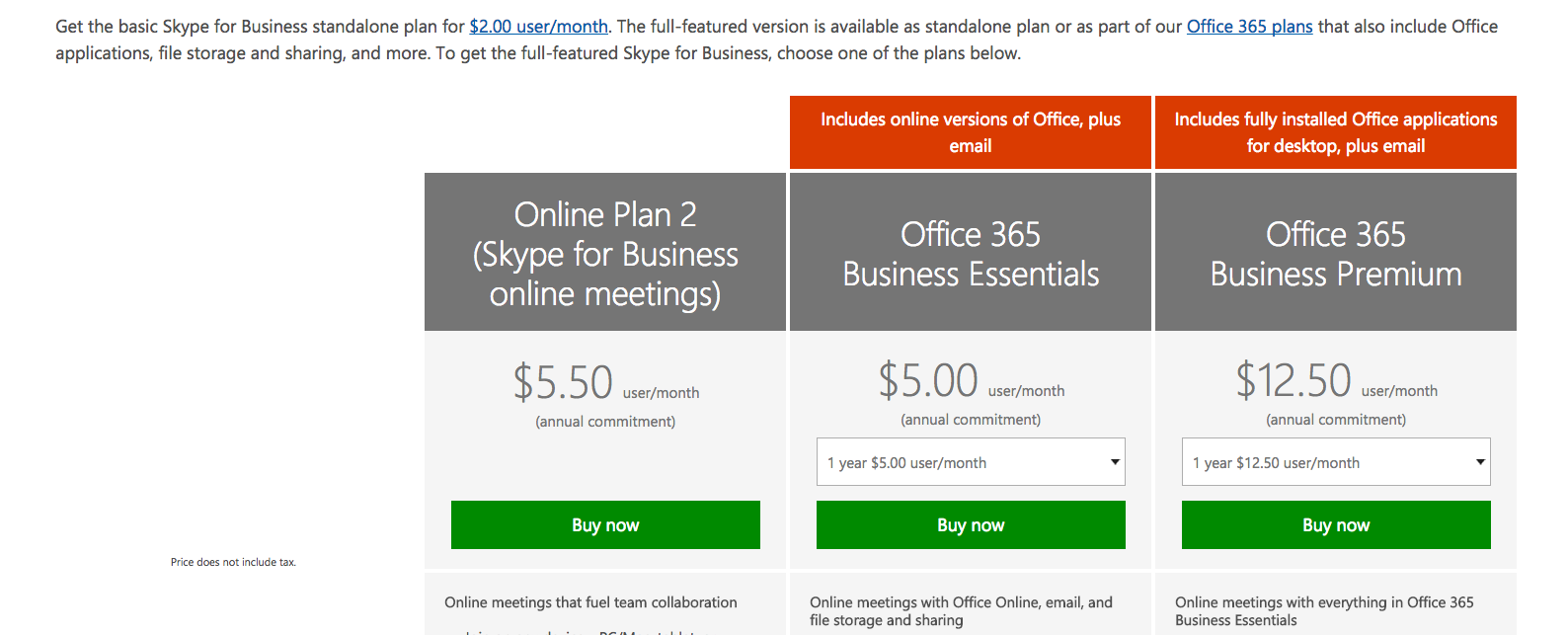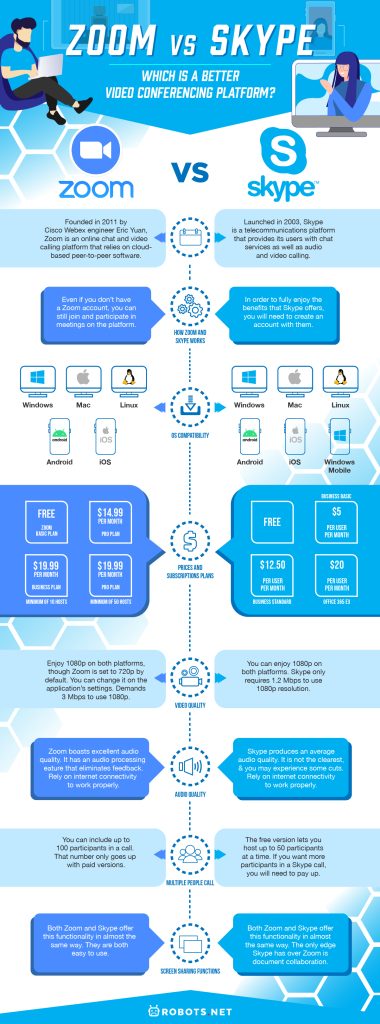Video Conferencing as We Know It
Communication has certainly come a long way since the invention of the telephone. Everything is digital now, and the world relies on an internet connection to stay in the loop. The speedy connectivity and advancements in technology have both contributed to the rapid progress of communication. What started as purely audio communication has now fully evolved into video calls and conferencing. Today, many computer and mobile applications have integrated video conferencing capabilities. Even social media has provided us with video functions. Facebook, for instance, allows its users to call via audio or video. And then there are applications and platforms that hinge largely on their video calling features. In this aspect, two platforms immediately come into mind: Zoom and Skype. If you find yourself at a crossroads between the two applications and need to come to a decision, there are many things you must take into account first. We will discuss everything you need to know about Zoom and Skype below.
Zoom vs Skype: Introduction
What Is Zoom?
Founded in 2011 by Cisco Webex engineer Eric Yuan, Zoom is an online chat and video calling platform that relies on cloud-based peer-to-peer software. It is a leader in teleconferencing and distance education. Despite its founding in 2011, the software itself did not launch until two years later. Still, Zoom swiftly climbed through the ranks and evolved into a household name. By 2017, the company achieved a valuation of $1 billion — a truly magnificent feat. It was not until 2019, though, that Zoom became profitable. In the same year, it launched its initial public offering.
What Is Skype?
Launched in 2003, Skype is a telecommunications platform that provides its users with chat services as well as audio and video calling. In 2011, Microsoft bought Skype, including its proprietary software, for $8.5 billion. As a result of the acquisition, Microsoft has since discontinued its own messaging services and integrated Skype into its products instead. Today, Skype remains a mainstay among businesses and households.
Understanding How Zoom and Skype Work
A lot of factors have influenced the skyrocketing popularity of both Zoom and Skype. It stems from a shift in workplace settings and the professional landscape, but the global pandemic in 2020 also largely contributed to the increase in usage. Due to a need to stay and work at home, businesses now rely on video conferencing as a primary mode of communication and meeting. For schools, online classrooms have become the new norm. If nothing else, Zoom and Skype allow friends and family to interact without the need for an in-person social gathering.
How Skype Works
Skype is relatively simple to use with an easy-to-understand interface. However, in order to fully enjoy the benefits that Skype offers, you will need to create an account with them. This requires you to sign up with an email address and set your Skype ID and password. With a Skype ID, you can use the platform to send instant messages to your contacts and even call them via audio or video. While you can connect with people who are not in your address book, it will require knowledge of their Skype ID or associated email address. Once you send a message to the other person, you will find your chat history saved. All you need to do to continue communicating with the person is to open the same chat.
How Zoom Works
Whereas Skype requires the creation of an account to use, Zoom does not necessarily follow this same pattern. Even if you don’t have a Zoom account, you can still join and participate in meetings on the platform. Of course, this is provided you know the Zoom meeting ID. You will typically receive an invite to join a meeting via email, phone, instant message, browser, or the platform itself. Once you have that, you will need a desktop or mobile application. Just enter the meeting ID and start video conferencing. On the other hand, if you want to create a meeting instead of simply joining one, you will need a Zoom account. Once you have an account, simply sign into the application and click on “Host a Meeting” or “New Meeting.” You can invite members by selecting users from your contacts list or manually typing in their email addresses. Alternatively, you can copy the invitation link and send it to all your members.
Zoom vs Skype: Similarities
As both are primarily used for video conferencing, Zoom and Skype share many similarities. For instance, they both have screen-sharing capabilities as well as video recording functions. They both allow you to call or video conference with multiple people. Additionally, both Zoom and Skype have applications for desktops, laptops, and mobile devices. As mentioned previously, Zoom allows you to join meetings even without an account with them. While the opposite was true for Skype in the past, the communications giant has since adopted a similar strategy. A new feature called Meet Now permits users to enter a video call without needing to sign up for an account. You’re not even forced to download the app itself. This is the same with Zoom, from whom Skype seemed to borrow the idea for the new feature. Similar to Zoom, Skype produces a unique link that you can share with other people to join a video call. This is the time that you need to have a Skype account. You need to sign in to the platform and generate the meeting link. However, other people need not to worry about creating an account to participate in the video conference. You can invite anyone you like, and those who accept the invitation can make use of the same set of features Skype offers account holders.
Zoom vs Skype: Differences
While Zoom and Skype do share plenty of similarities, they also have their differences. While some said Skype is just another Zoom alternative, some strongly disagree. This is not surprising given both platform’s desire to stand out from the rest. It is a competitive world out there, and service providers like Zoom and Skype need to constantly improve their features and come up with new ones in order to remain relevant. Let us discuss the differences between Zoom vs Skype per category.
OS Compatibility
While both Zoom and Skype can be accessed via desktop, laptop, and mobile devices, there are differences when it comes to operating systems. The major operating systems are a given — Zoom and Skype are both compatible with Windows, Mac, Android, and iOS. They also both have web-based services that do not require you to download the desktop or laptop client. If needed, you can freely navigate Zoom and Skype in browser mode. Apart from that, both are available on Linux. When it comes to operating systems, though, Skype may have an edge over Zoom. Skype is also available on Windows mobile, which is not surprising at all given that the platform is owned by Microsoft. This added benefit mainly affects those with Windows mobile operating systems, so it does not really matter to other users. Still, it is worth considering.
Prices and Subscriptions Plans
One of the factors that greatly influence a user’s decision is the price. More often than not, users tend to go for cheaper or free service. The good news is, both Zoom and Skype offer free versions of their video conferencing platform. Of course, paid versions of Zoom and Skype offer more features and benefits. Let us break down the different pricing plans between Zoom and Skype below:
Zoom Plans
The Zoom pricing plan can be categorized as such: The Zoom Basic plan is free and includes the following features:
Unlimited one-on-one meetings Unlimited group meetings Up to 100 participants Meeting time up to 40 minutes 720p video quality Screensharing Breakout rooms HD voice and video Virtual background Private and group chats Host controls Co-annotation on Screen Share Remote control (keyboard and mouse) Whiteboard feature Multi-share TLS Encryption and AES-256 Encryption for real-time content Waiting room Email support
The Pro plan costs $14.99 per month. It gives the host access to the following features and add-ons:
All Basic plan features with upgraded participant count to 100 and meeting duration to 24 hours Email and live chat support Toll-based phone dial-in 1 GB cloud recording Assign someone as Meeting Scheduler Skype for Business interoperability Streaming to social media Usage reports Management of users and roles
The Business plan requires a minimum of 10 hosts for the subscription. It costs $19.99 per month per host and offers the following features:
All Pro plan features but upgraded to 300 participants Email, live chat, and phone support Admin portal LTI integration Transcripts of cloud recordings Branding and page customization Managed domains Single sign-on Language interpretation
The Enterprise plan costs $19.99 per month per host with a minimum of 50 hosts. It includes the following features:
All Business plan features but upgraded to 500 participants (or 1,000 for Enterprise Plus) Unlimited cloud storage Dedicated Customer Success Manager Executive business reviews Bundle discounts on Webinars and Zoom Rooms
Skype Plans
Skype is generally free to use, though you do need to pay as you go to make international calls that do not rely on an internet connection. For large-scale use, you can take advantage of Skype for Business, which allows up to 250 participants. It’s important to note that Microsoft Teams will soon be replacing Skype for Business. Microsoft Teams merges instant messaging, calling, video conferencing, and document collaboration into one fully integrated app. Like Zoom, Microsoft Teams comes with a free version. There are three paid subscription plans to choose from Business Basic ($5 per user per month), Business Standard ($12.50 per user per month), and Office 365 E3 ($20 per user per month).
Video Quality
For many freelancers and businesses, video quality matters a lot. To some degree, video calling is meant to replace or stand in for in-person meetings. And what good is a video conferencing application if it offers poor quality? Luckily, both Zoom and Skype offer high-definition video quality. You can enjoy 1080p on both platforms, though Zoom is set to 720p by default. You can change the video quality by going to the application’s settings, whether outside or during a meeting. With 1080p, you can see other participants in crystal clear definition. Though, it is worth noting that there is a difference between Zoom vs Skype when it comes to Mbps requirements for 1080p. Zoom demands 3 Mbps to use 1080p, whereas Skype only requires 1.2 Mbps to use the same resolution. As such, if the Mbps requirement holds significance to you, you may want to consider Skype.
Audio Quality
Another element that a lot of people consider is audio quality. When it comes to calls (voice or video), you obviously want to hear the other person or people loud and clear. Otherwise, your meetings are vulnerable to miscommunication. Talking and listening are also much more efficient than instant messaging, which both platforms allow you to use even during a video conference or call. So, what do Zoom and Skype have to offer in terms of audio quality? Skype produces an average audio quality. It is not the clearest, and you may experience some cuts or lags every now and then. On the other hand, Zoom boasts excellent audio quality. It has an audio processing feature that eliminates feedback, allowing for clearer and crisper audio. Of course, both Zoom and Skype rely on internet connectivity to work properly. So, if your internet connection is unstable, you will definitely experience poor audio quality. Additionally, if you have a terrible mic, it will also affect how other people hear you.
Multiple People Call
As stated above, Zoom and Skype allow you to video conference with numerous people at the same time. However, they do have their shortcomings. This is most apparent in their free versions. When you use the free or basic version of Zoom, you can include up to 100 participants in a call. That number only goes up with paid versions. It is possible to reach 1,000 participants with its Enterprise Plus plan. Skype, on the other hand, pales in comparison. The free version of Skype lets you host up to 50 participants at a time. That is half the amount of people Zoom allows for the same free version. If you want more participants in a Skype call, you will need to pay up. But that would only let you gather up to 250 participants simultaneously. So, when it comes to the number of participants, Zoom definitely has the upper hand over Skype.
Screen Sharing Functions
When conducting meetings, screen-sharing can be very beneficial. The aptly named function allows you to share screens with other users during the call. Both Zoom and Skype offer this functionality in almost the same way. They are both easy to use, which is great for those who are not very familiar with the technology. The only edge Skype has over Zoom when it comes to sharing functions is document collaboration. Since it is integrated with Microsoft Office, users can simultaneously work on the same document during the video call.
Zoom vs Skype: Benefits of Both Platforms
There are clearly many advantages to using either Zoom or Skype, and you can use these to influence your final decision. Let us examine the benefits of either platform here:
Zoom Benefits
With Zoom, not only can you video chat with up to 1,000 users (paid), but you also have access to a multitude of features. You can record and save the entire session for easy documentation and even brainstorm ideas together using the on-screen whiteboard. Zoom also offers meeting analytics and integrations with Slack and Zapier. In terms of security, Zoom boasts end-to-end encryption, protecting your calls and messages. However, it is worth noting that Zoom received some flak recently due to privacy issues. In fact, in April, the company announced that it was putting a pause on new features for 90 days to work on security and privacy concerns.
Skype Benefits
With Skype, you can take advantage of instant messaging and video chat features. However, it has the added benefit of making domestic and international calls, though you do need to pay for that, too. Still, it is a feature that Zoom does not have, so it is worth mentioning. As mentioned before, you can share your screen with other participants on Skype as well as share documents. You can post a poll, hold a Q&A session, and even use a whiteboard feature similar to its competitors. Skype also boasts end-to-end encryption. Perhaps one of the main benefits of Skype is its relation to Microsoft Teams, which will integrate many features.
The Bottom Line
As you can see, it is hard to make a choice in the Zoom vs Skype battle. Both of these platforms have impressive features and competitive pricing plans. There are aspects when one of them has an obvious edge over the other, such as Zoom’s 100-participant limit compared to Skype 50-participant limit for free versions. However, when it comes down to it, they are pretty neck and neck. Then again, you can always use both Zoom and Skype. You can either pay for both services, pay for only one service and use the other for free or use the free version of both.













